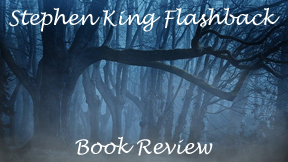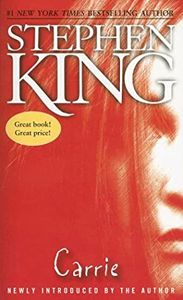Stephen King makes a remarkable debut with “Carrie” (1974), a rough-and-tumble but intensely readable short novel that’s perhaps more notable for its influence than for its own greatness. His prose is engrossing (if clunky now and then). And he smartly uses a trick of a reportage style — looking back on the events via commission reports and newspaper articles — to show scope and societal perspective.
Classic plot
The plot is incredibly simple. (SPOILERS FOLLOW, as if anyone is unfamiliar with the story.) High schooler Carrie White has her first menstrual period in the gym shower and her classmates taunt her. Sue Snell’s boyfriend Tommy invites Carrie to the prom as a makeup gesture by Sue, who feels bad about participating in the taunting. Christine and Billy, expelled from the prom, dump pig blood on Carrie, who then unleashes her telekinetic powers on heretofore sleepy Chamberlain, Maine.
King sets the action in the near future of 1979. And the reactions to the events take place throughout the 1980s. Maybe he thought TK would play more plausibly if it happens in the future. But since I’m reading the book decades later, the dates don’t matter.

King’s strength out of the gate is getting into people’s minds. “Carrie” isn’t about what people do, but about how people feel about what they do (or don’t do). We always know what Carrie is feeling. When we cut to Sue, Billy, the gym teachers, etc., we know their thoughts about Carrie. Interestingly, Carrie’s TK powers have a convenient side effect for writing purposes: Everyone in town knows Carrie is causing the destruction, even if they’ve never met her or even heard of her.
“Carrie” is partially a story of bullying, as Carrie has created a shell around her after previous events. At home, she’s psychologically brutalized by her religious mother, who locks her in a closet for hours at a time.
But King taps into the notion that would be crisply illustrated in the “Buffy” Season 3 episode “Earshot”: Teenagers are self-centered and indifferent more so than cruel. The students briefly rise up to make fun of Carrie when she does something weird, but they don’t strategize (with the exception of Christine).
Finding some sympathy
Granted, Carrie is on people’s minds because the shower incident becomes locally infamous. But Sue, the gym teacher and the assistant principal are sympathetic. Tommy flat-out likes Carrie. Christine and Billy don’t think about revenge on Carrie all that much when planning the pig blood stunt; Billy thinks about his future, Chris thinks about Billy.
In the briefly happy middle section, Carrie has a nice time at the prom with Tommy and his friends. She easily slides into the group, talking openly. They all immediately like her. She can’t dance, but neither can Tommy, so it’s no big deal.

King doesn’t quite earn this segment, nor the “She’s All That” transformation that precedes it. Carrie is a skilled seamstress, so she makes her own beautiful dress. But her house includes only one crappy mirror, and King makes no mention of hair or makeup supplies. It’s not believable when Tommy and others are struck by Carrie’s physical beauty.
The obvious, and perhaps better, tactic would be to have Sue give Carrie a makeover. Instead, Sue is at home, brooding in penance for taunting Carrie.
In that opening shower scene, King establishes Carrie as a frumpy, pimple-covered toad who grunts like a creature more so than like a human. Through sheer determination, rather than help or research, Carrie makes herself physically beautiful for the prom.
Nurture (or lack thereof) over nature
King is more on point when describing how Carrie turned out so awkward. Interestingly, it’s not because of shyness. I made the mistake of thinking of Carrie as being naturally socially awkward entering this book, but “Carrie” is about nurture (or the lack thereof) more so than nature. She is badgered into a shell by her mother’s treatment. Students’ reactions to her weirdness are merely a case of piling on.
Margaret White is almost a hilarious parody of extreme religiousness. King digs into her through flashbacks. The act of conceiving Carrie with her husband is so shameful to Margaret that she considered suicide and infanticide multiple times.
Interestingly, those things go against the Bible even more so than sex, don’t they? Well, at any rate, Margaret is crazy. That begs the question of how she got that way. But if the answer is “She was raised that way” then we’d constantly be going back in time.
One generation is enough to show how a child is shaped by her parent(s), and that’s the scope of King’s novel. Even though a small percentage of scenes feature mother and daughter, this is “Carrie’s” emotional center. Carrie hates her mother but also loves her. (In parallel, she hates her classmates but wishes she could love them and be like them. In the happy time at the prom, she marvels at how beautiful everyone is.)
King creates the ultimate character-study of a horror villain, and a sympathetic one (although maybe everyone is sympathetic when you get this personal). I don’t consider myself a fan of conformity or public school, but even I was disgusted by Carrie for not getting with the program on the most basic level. But I opposed her mistreatment. As a reader, I was essentially Sue, wringing my hands.
Because the events are so personal yet universal, easily avoidable yet inevitable, “Carrie” is soaked with tragedy as much as Carrie’s dress is soaked with blood. It’s not the densest novel, but King’s raw writing talent is obvious.
On Fridays, RFMC reviews a Stephen King book, adaptation or related work. Click here to visit our Stephen King Zone.

